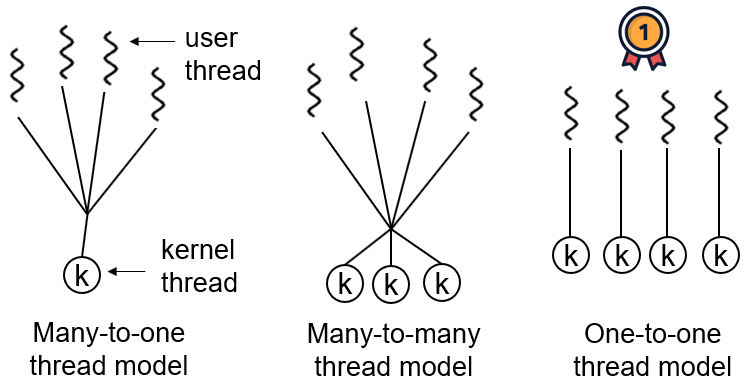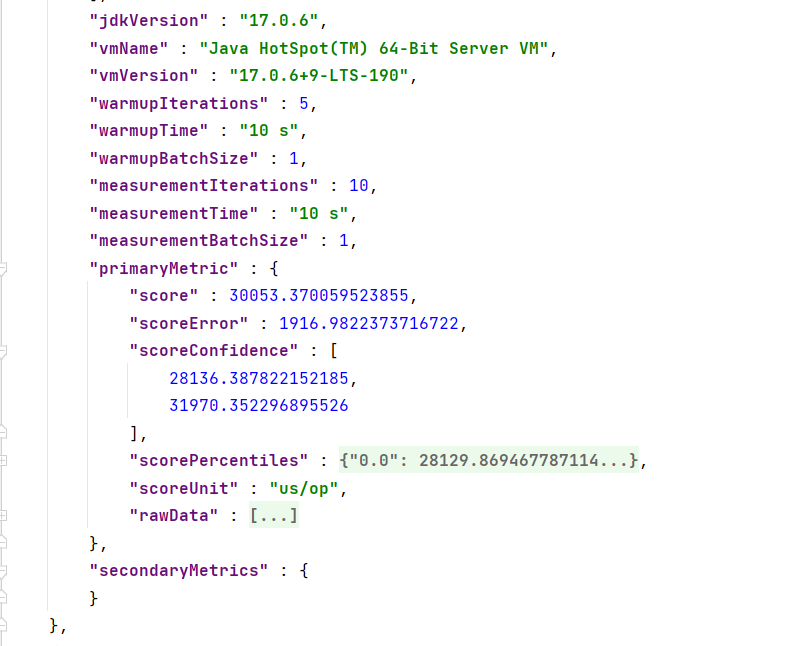IO流原理及流的分类
原理
1.I/O是Input/Output的缩写, I/O技术是非常实用的技术,用于处理设备之间的数据传输。如读/写文件,网络通讯等。
2.Java程序中,对于数据的输入/输出操作以“流(stream)” 的方式进行。
3.java.io包下提供了各种“流”类和接口,用以获取不同种类的数据,并通过标准的方法输入或输出数据。
输入input:读取外部数据(磁盘、光盘等存储设备的数据)到程序(内存)中。
输出output:将程序(内存)数据输出到磁盘、光盘等存储设备中
流的分类
1.按操作数据单位不同分为:字节流(8 bit),字符流(16 bit)
2.按数据流的流向不同分为:输入流,输出流
3.按流的角色的不同分为:节点流,处理流

字节流通常处理非文本文件
字符流通常用来处理文本文件
1.Java的IO流共涉及40多个类,实际上非常规则,都是从如下4个抽象基类派生的。
2.由这四个类派生出来的子类名称都是以其父类名作为子类名后缀。
流的体系结构:
| 抽象基类 |
节点流(或文件流) |
缓冲流(处理流的一种) |
| InputStream |
FileInputStream |
BufferedInputStream |
| outputStream |
FiLeoutputStream |
BufferedOutputStream |
| Reader |
FiLeReader |
BufferedReader |
| writer |
Filewriter |
Bufferedwriter |

节点流和处理流
- ==节点流==:直接从数据源或目的地读写数据
- ==处理流==:不直接连接到数据源或目的地,而是“连接”在已存在的流(节点流或处理流)之上,通过对数据的处理为程序提供更为强大的读写功能
1
2
3
4
5
6
7
8
9
10
11
12
13
14
15
16
17
18
19
20
21
22
23
| @Test
void t1() {
File file = new File("helloJavaIO.txt");
FileReader fr = null;
try {
fr = new FileReader(file);
int data;
while ((data = fr.read()) != -1) {
System.out.print((char) data);
}
fr.close();
} catch (FileNotFoundException e) {
e.printStackTrace();
System.out.println("找不到文件! ");
} catch (IOException e) {
e.printStackTrace();
System.out.println("读取字符失败! ");
}
}
|
1️⃣节点流(或文件流)
🍅读取文件
1.建立一个流对象,将已存在的一个文件加载进流。
`FileReader fr = new FileReader(new File(“Test.txt”));`
2.创建一个临时存放数据的数组。
char[] ch = new char[1024];
3.调用流对象的读取方法将流中的数据读入到数组中。
`fr.read(ch);`
4.关闭资源。
`fr.close();`
🍅写入文件
1.创建流对象,建立数据存放文件
`FileWriter fw = new FileWriter(new File(“Test.txt”));`
2.调用流对象的写入方法,将数据写入流
`fw.write(“atguigu-songhongkang”);`
3.关闭流资源,并将流中的数据清空到文件中。
` fw.close();`
InputStream 和 Reader 是所有输入流的基类。
==InputStream==(典型实现:FileInputStream)
- int read()
- int read(byte[] b)
- int read(byte[] b, int off, int len)
==Reader==(典型实现:FileReader)
程序中打开的文件 IO 资源不属于内存里的资源,垃圾回收机制无法回收该资源,所以应该显式关闭文件 IO 资源。
FileInputStream 从文件系统中的某个文件中获得输入字节。FileInputStream 用于读取非文本数据之类的原始字节流。要读取字符流,需要使用 FileReader
**int read()**从输入流中读取数据的下一个字节。返回 0 到 255 范围内的 int 字节值。如果因为已经到达流末尾而没有可用的字节,则返回值 -1。
**int read(byte[] b)**从此输入流中将最多 b.length 个字节的数据读入一个 byte 数组中。如果因为已经到达流末尾而没有可用的字节,则返回值 -1。否则以整数形式返回实际读取的字节数。
**int read(byte[] b, int off,int len)**将输入流中最多 len 个数据字节读入 byte 数组。尝试读取 len 个字节,但读取的字节也可能小于该值。以整数形式返回实际读取的字节数。如果因为流位于文件末尾而没有可用的字节,则返回值 -1。
public void close() throws IOException关闭此输入流并释放与该流关联的所有系统资源。
🌳Reader
**int read()**读取单个字符。作为整数读取的字符,范围在 0 到 65535 之间 (0x00-0xffff)(2个字节的Unicode码),如果已到达流的末尾,则返回 -1
**int read(char[] cbuf)**将字符读入数组。如果已到达流的末尾,则返回 -1。否则返回本次读取的字符数。
**int read(char[] cbuf,int off,int len)**将字符读入数组的某一部分。存到数组cbuf中,从off处开始存储,最多读len个字符。如果已到达流的末尾,则返回 -1。否则返回本次读取的字符数。
public void close() throws IOException关闭此输入流并释放与该流关联的所有系统资源
1
2
3
4
5
6
7
8
9
10
11
12
13
14
15
16
17
18
19
20
21
22
23
24
25
26
27
28
29
30
31
32
33
34
35
36
37
38
39
40
41
42
43
44
45
46
47
48
49
50
51
52
53
54
55
56
57
58
59
60
61
62
63
64
65
66
67
68
69
70
71
72
73
74
75
76
77
78
79
80
81
82
83
84
85
86
87
88
89
90
91
92
93
94
95
96
97
98
99
100
101
102
103
104
105
| package pers.dhx_.java0620;
import org.junit.jupiter.api.Test;
import java.io.File;
import java.io.FileNotFoundException;
import java.io.FileReader;
import java.io.IOException;
public class FileReaderWriterTest {
@Test
void t1() {
File file = new File("helloJavaIO.txt");
FileReader fr = null;
try {
fr = new FileReader(file);
int data;
while ((data = fr.read()) != -1) {
System.out.print((char) data);
}
} catch (FileNotFoundException e) {
e.printStackTrace();
System.out.println("找不到文件! ");
} catch (IOException e) {
e.printStackTrace();
System.out.println("读取字符失败! ");
} finally {
if (fr != null) {
try {
fr.close();
} catch (IOException e) {
e.printStackTrace();
}
}
}
}
@Test
void t2() {
File file = new File("helloJavaIO.txt");
FileReader fr = null;
try {
fr = new FileReader(file);
} catch (FileNotFoundException e) {
e.printStackTrace();
}
char[] cbuf = new char[5];
int len = 0, cnt = 1;
try {
while (((len = fr.read(cbuf)) != -1)) {
System.out.println("第 " + cnt++ + "次 : 字符数量" + len);
for (int i = 0; i < len; i++) {
System.out.println(cbuf[i]);
}
}
} catch (IOException e) {
e.printStackTrace();
} finally {
try {
fr.close();
} catch (IOException e) {
e.printStackTrace();
}
}
}
}
|
2.OutputStream & Writer
1.OutputStream 和 Writer 也非常相似:
**void write(**int b / int c);
**void write(**byte[] b/char[] cbuf);
**void write(**byte[] b/char[] buff, int off, int len);
void flush();
void close(); 需要先刷新,再关闭此流
2.因为字符流直接以字符作为操作单位,所以 Writer 可以用字符串来替换字符数组,即以 String 对象作为参数
void write(String str);
void write(String str, int off, int len);
3.FileOutputStream 从文件系统中的某个文件中获得输出字节.FileOutputStream ==用于写出非文本数据之类的原始字节流==。要写出字符流,需要使用 FileWriter
💃OutputStream
**void write(int b)**将指定的字节写入此输出流。write 的常规协定是:向输出流写入一个字节。要写入的字节是参数 b 的八个低位。b 的 24 个高位将被忽略。 即写入0~255范围的。
**void write(byte[] b)**将 b.length 个字节从指定的 byte 数组写入此输出 流。write(b) 的常规协定是:应该与调用 write(b, 0, b.length) 的效果完全相同。
**void write(byte[] b,int off,int len)**将指定 byte 数组中从偏移量 off 开始的 len 个字节写入此输出流。
public void flush()throws IOException刷新此输出流并强制写出所有缓冲的输出字节,调用此方法指示应将这些字节立即写入它们预期的目标。
public void close() throws IOException关闭此输出流并释放与该流关联的所有系统资源。
💃Writer
==对于文件的写入:==
实际代码过程中发现如果不 关闭流资源,就无法完成正常的文件写入、
注意不弄使用字符流处理字节流数据(图片、视频等)。
如果文件不存在会自动创建
如果存在就看FileWriter的构造器是用的哪个
- 如果用的构造器是FileWriter(file,false) 或者 FileWriter(file),就会覆盖原有的文件。
- 如果用的构造器是FileWriter(file,true) ,就会再原有的文件基础上追加内容。
**void write(int c)**写入单个字符。要写入的字符包含在给定整数值的 16 个低位中,16 高位被忽略。 即写入0 到 65535 之间的Unicode码。
**void write(char[] cbuf)**写入字符数组。
**void write(char[] cbuf,int off,int len)**写入字符数组的某一部分。从off开始,写入len个字符。
**void write(String str)**写入字符串。
**void write(String str,int off,int len)**写入字符串的某一部分。
**void flush()**刷新该流的缓冲,则立即将它们写入预期目标。
public void close() throws IOException关闭此输出流并释放与该流关联的所有系统资源。
1
2
3
4
5
6
7
8
9
10
11
| @Test
void t1() throws IOException {
File file = new File("FileWriter_.txt");
FileWriter fw = new FileWriter(file);
fw.write(1);
fw.write('5');
fw.write("5345!@%$%I_534g435_");
fw.close();
}
|
1
2
3
4
5
6
7
8
9
10
11
12
13
14
15
16
17
18
19
20
21
22
23
24
25
26
27
28
29
30
31
32
33
34
35
36
37
38
39
40
41
42
43
44
45
46
47
48
49
50
51
52
53
54
55
56
57
58
59
60
61
62
63
64
65
66
67
68
69
70
71
72
73
74
75
76
77
78
79
80
81
82
83
84
85
86
87
88
89
90
91
92
93
94
95
96
97
98
99
100
101
102
103
104
105
106
| package pers.dhx_.java0620;
import org.junit.jupiter.api.Test;
import java.io.*;
public class FIleInputStreamTest {
@Test
void t1() {
File file = new File("helloJavaIO.txt");
FileInputStream fis = null;
try {
fis = new FileInputStream(file);
byte[] buffer = new byte[5];
int len;
while ((len = fis.read(buffer)) != -1) {
String s = new String(buffer, 0, len);
System.out.println(s);
}
} catch (IOException e) {
e.printStackTrace();
} finally {
try {
fis.close();
} catch (IOException e) {
e.printStackTrace();
}
}
}
@Test
void t2() {
File srcFile = new File("$QCA4KG1[{ZH9GYHMP%5%C0.jpg");
File DesFile = new File("$picture.jpg");
FileInputStream fis = null;
try {
fis = new FileInputStream(srcFile);
FileOutputStream fos = new FileOutputStream(DesFile);
byte[] buffer = new byte[256];
int len;
while ((len = fis.read(buffer)) != -1) {
fos.write(buffer, 0, len);
}
} catch (FileNotFoundException e) {
e.printStackTrace();
} catch (IOException e) {
e.printStackTrace();
} finally {
try {
fis.close();
fis.close();
} catch (IOException e) {
e.printStackTrace();
}
}
}
public static void copyFile(String srcPath, String desPath) {
File srcFile = new File(srcPath);
File desFile = new File(desPath);
FileInputStream fis = null;
try {
fis = new FileInputStream(srcFile);
FileOutputStream fos = new FileOutputStream(desFile);
byte[] buffer = new byte[8196];
int len;
while ((len = fis.read(buffer)) != -1) {
fos.write(buffer, 0, len);
}
} catch (FileNotFoundException e) {
e.printStackTrace();
} catch (IOException e) {
e.printStackTrace();
} finally {
try {
fis.close();
fis.close();
} catch (IOException e) {
e.printStackTrace();
}
}
}
@Test
void copyFileTest() {
long start = System.currentTimeMillis();
copyFile("C:\\Users\\lenovo\\Videos\\test.mkv", "C:\\Users\\lenovo\\Desktop\\JavaIOFileInputStream_Test.mkv");
long end = System.currentTimeMillis();
System.out.println("复制文件耗时 " + (end - start) + " ms");
}
}
|
总结
1.定义文件路径时,注意:可以用“/”或者“\”。
2.在写入一个文件时,如果使用构造器FileOutputStream(file),则目录下有同名文件将被覆盖。
3.如果使用构造器FileOutputStream(file,true),则目录下的同名文件不会被覆盖,在文件内容末尾追加内容。
4.在读取文件时,必须保证该文件已存在,否则报异常。
5.字节流操作字节,比如:.mp3,.avi,.rmvb,mp4,.jpg,.doc,.ppt
6.字符流操作字符,只能操作普通文本文件。最常见的文件:.txt,.java,.c,.cpp 等语言的源代码。尤其注意.doc,excel,ppt这些不是文本文件。
2️⃣缓冲流
- ==为了提高数据读写的速度==,Java API提供了带缓冲功能的流类,在使用这些流类时,会创建一个内部缓冲区数组,缺省使用8192个字节(8Kb)的缓冲区。

细节
1.当读取数据时,数据按块读入缓冲区,其后的读操作则直接访问缓冲区
2.当使用BufferedInputStream读取字节文件时,BufferedInputStream会一次性从文件中读取8192个(8Kb),存在缓冲区中,直到缓冲区装满了,才重新从文件中读取下一个8192个字节数组。
3.向流中写入字节时,不会直接写到文件,先写到缓冲区中直到缓冲区写满,BufferedOutputStream才会把缓冲区中的数据一次性写到文件里。使用方法flush()可以强制将缓冲区的内容全部写入输出流
4.关闭流的顺序和打开流的顺序相反。只要关闭最外层流即可,关闭最外层流也会相应关闭内层节点流
5.flush()方法的使用:手动将buffer中内容写入文件
6.如果是带缓冲区的流对象的close()方法,不但会关闭流,还会在关闭流之前刷新缓冲区,关闭后不能再写出

1
2
3
4
5
6
7
8
9
10
11
12
13
14
15
16
17
18
19
20
21
22
23
24
25
26
27
28
29
30
31
32
33
34
35
36
37
| void t1() {
BufferedReader br = null;
BufferedWriter bw = null;
try {
br = new BufferedReader(new FileReader("d:\\IOTest\\source.txt"));
bw = new BufferedWriter(new FileWriter("d:\\IOTest\\dest.txt"));
String str;
while ((str = br.readLine()) != null) {
bw.write(str);
bw.newLine();
}
bw.flush();
} catch (IOException e) {
e.printStackTrace();
} finally {
try {
if (bw != null) {
bw.close();
}
} catch (IOException e) {
e.printStackTrace();
}
try {
if (br != null) {
br.close();
}
} catch (IOException e) {
e.printStackTrace();
}
}
}
|
🍅使用缓冲流复制非文本文件
1
2
3
4
5
6
7
8
9
10
11
12
13
14
15
16
17
18
19
20
21
22
23
24
25
26
27
28
29
30
31
32
33
34
35
36
37
38
39
40
41
42
43
| package pers.dhx_.java0620;
import org.junit.jupiter.api.Test;
import java.io.*;
public class BufferInputStreamTest {
@Test
void t1() throws Exception {
long start = System.currentTimeMillis();
File srcFile = new File("C:\\Users\\lenovo\\Videos\\test.mkv");
File desFile = new File("C:\\Users\\lenovo\\Desktop\\test.mkv");
FileInputStream fis = new FileInputStream(srcFile);
FileOutputStream fos = new FileOutputStream(desFile);
BufferedInputStream bis = new BufferedInputStream(fis);
BufferedOutputStream bos = new BufferedOutputStream(fos);
byte[] buffer = new byte[56];
int len;
while ((len = bis.read(buffer)) != -1) {
bos.write(buffer, 0, len);
}
bis.close();
bos.close();
fis.close();
fos.close();
long end = System.currentTimeMillis();
System.out.println("复制文件耗时 " + (end - start) + " ms");
}
}
|
⭕使用缓冲流复制文本文件
1
2
3
4
5
6
7
8
9
10
11
12
13
14
15
16
17
18
19
20
21
22
23
24
25
26
27
28
29
30
31
32
33
34
35
36
37
38
| @Test
void t2() throws Exception {
long start = System.currentTimeMillis();
File srcFile = new File("helloJavaIO.txt");
File desFile = new File("C:\\Users\\lenovo\\Desktop\\test.txt");
FileReader fis = new FileReader(srcFile);
FileWriter fos = new FileWriter(desFile);
BufferedReader br = new BufferedReader(fis);
BufferedWriter bw = new BufferedWriter(fos);
String data = "";
while ((data = br.readLine()) != null) {
bw.write(data + '\n');
}
br.close();
bw.close();
long end = System.currentTimeMillis();
System.out.println("复制文件耗时 " + (end - start) + " ms");
}
|
练习

1
2
3
4
5
6
7
8
9
10
11
12
13
14
15
16
17
18
19
20
21
22
23
24
25
26
27
28
29
30
31
32
33
34
35
36
37
38
39
40
41
42
43
44
45
46
47
48
49
50
51
52
53
54
55
56
57
58
59
60
61
62
63
64
65
66
67
68
69
70
| package pers.dhx_.java0620.pictureTest;
import org.junit.jupiter.api.Test;
import java.io.*;
import java.util.HashMap;
import java.util.Map;
public class PicTest {
@Test
void t1() throws Exception {
FileInputStream fis = new FileInputStream("$picture.jpg");
FileOutputStream fos = new FileOutputStream("Secret_picture.jpg");
byte[] buffer = new byte[48];
int len;
while ((len = fis.read(buffer)) != -1) {
for (int i = 0; i < len; i++) {
buffer[i] ^= 5;
}
fos.write(buffer, 0, len);
}
fis.close();
fos.close();
}
@Test
void t2() throws Exception {
FileInputStream fis = new FileInputStream("Picture/Secret_picture.jpg");
FileOutputStream fos = new FileOutputStream("Picture/decrypt_Secret_picture.jpg");
byte[] buffer = new byte[48];
int len;
while ((len = fis.read(buffer)) != -1) {
for (int i = 0; i < len; i++) {
buffer[i] ^= 5;
}
fos.write(buffer, 0, len);
}
fis.close();
fos.close();
}
@Test
void t3() {
Map<Character, Integer> map = new HashMap<>();
File srcFile = new File("Txt/FileWriter_.txt");
FileReader fr = null;
try {
fr = new FileReader(srcFile);
int c;
while ((c = fr.read()) != -1) {
char ch = (char) c;
if (map.containsKey(ch)) {
Integer cnt = map.get(ch);
map.put(ch, cnt + 1);
} else {
map.put(ch, 1);
}
}
} catch (IOException ex) {
ex.printStackTrace();
}
System.out.println(map);
}
}
|
3️⃣转换流
Java API提供了两个转换流:
InputStreamReader:将InputStream转换为Reader
OutputStreamWriter:将Writer转换为OutputStream
==字节流中的数据都是字符时,转成字符流操作更高效。==
很多时候我们使用转换流来处理文件乱码问题。实现编码和解码的功能。
实现将==字节的输入流==按指定字符集转换为字符的输入流。
构造器
public InputStreamReader(InputStream in)
public InputSreamReader(InputStream in,String charsetName)
==charsetName 为指定字符集==
如: Reader isr = new InputStreamReader(System.in,”gbk”);
OutputStreamWriter
实现将==字符的输出流==按指定字符集转换为==字节的输出流==。
理解 :
构造器
public OutputStreamWriter(OutputStream out)
public OutputSreamWriter(OutputStream out,String charsetName)

1
2
3
4
5
6
7
8
9
10
11
12
13
14
15
16
17
| @Test
public void testMyInput() throws Exception {
FileInputStream fis = new FileInputStream("dbcp.txt");
FileOutputStream fos = new FileOutputStream("dbcp5.txt");
InputStreamReader isr = new InputStreamReader(fis, "GBK");
OutputStreamWriter osw = new OutputStreamWriter(fos, "GBK");
BufferedReader br = new BufferedReader(isr);
BufferedWriter bw = new BufferedWriter(osw);
String str = null;
while ((str = br.readLine()) != null) {
bw.write(str);
bw.newLine();
bw.flush();
}
bw.close();
br.close();
}
|
1
2
3
4
5
6
7
8
9
10
11
12
13
14
15
16
17
18
19
20
21
22
23
24
25
26
27
28
29
30
31
32
33
34
35
36
37
38
39
40
41
42
43
44
45
46
47
48
| package pers.dhx_.java0620;
import org.junit.jupiter.api.Test;
import java.io.*;
public class InputStreamReaderTest {
@Test
void t1() throws Exception {
FileInputStream fis = new FileInputStream("Txt\\FileWriter_.txt");
InputStreamReader isr = new InputStreamReader(fis, "Utf-8");
char[] cbuf = new char[10];
int len;
while ((len = isr.read(cbuf)) != -1) {
String s = new String(cbuf, 0, len);
System.out.println(s);
}
isr.close();
}
@Test
void t2() throws Exception {
File srcFile = new File("Txt\\FileWriter_.txt");
File desFile = new File("Txt\\OutputStreamWriterTest.txt");
FileInputStream fis = new FileInputStream(srcFile);
FileOutputStream fos = new FileOutputStream(desFile);
InputStreamReader isr = new InputStreamReader(fis);
OutputStreamWriter osr = new OutputStreamWriter(fos, "gbk");
char[] cbuf = new char[25];
int len;
while ((len = isr.read(cbuf)) != -1) {
osr.write(cbuf, 0, len);
}
isr.close();
osr.close();
}
}
|
⭐:字符编码
常见的编码表
ASCII
ISO8859-1
GB2312
GBK
- 中国的中文编码表升级,融合了更多的中文文字符号。最多两个字节编码
Unicode
- 国际标准码,融合了目前人类使用的所有字符。为每个字符分配唯一的字符码。所有的文字都用两个字节来表示。
UTF-8
1.Unicode不完美,这里就有三个问题,一个是,我们已经知道,英文字母只用一个字节表示就够了,第二个问题是如何才能区别Unicode和ASCII?计算机怎么知道两个字节表示一个符号,而不是分别表示两个符号呢?第三个,如果和GBK等双字节编码方式一样,用最高位是1或0表示两个字节和一个字节,就少了很多值无法用于表示字符,不够表示所有字符。Unicode在很长一段时间内无法推广,直到互联网的出现。
2.面向传输的众多 UTF(UCS Transfer Format)标准出现了,顾名思义,UTF- 8就是每次8个位传输数据,而UTF-16就是每次16个位。这是为传输而设计的编码,并使编码无国界,这样就可以显示全世界上所有文化的字符了。
3.Unicode只是定义了一个庞大的、全球通用的字符集,并为每个字符规定了唯一确定的编号,具体存储成什么样的字节流,取决于字符编码方案。推荐的Unicode编码是UTF-8和UTF-16。


编码:字符串(看得懂的)–>字节数组
解码:字节数组(看不懂的)–>字符串
转换流的编码应用
-
可以将字符按指定编码格式存储
-
可以对文本数据按指定编码格式来解读
-
指定编码表的动作由构造器完成
4️⃣标准输入、输出流( 了解 )
System.in: InputStream
System.java
1
| public static final InputStream in = null;
|
FilterOutputStream 的子类
- 重定向:通过System类的setIn,setOut方法对默认设备进行改变。
public static void setIn(InputStream in)
public static void setOut(PrintStream out)
⭕从键盘输入字符串,要求将读取到的整行字符串转成大写输出。然后继续进行输入操作,直至当输入“e”或者“exit”时,退出程序。
1
2
3
4
5
6
7
8
9
10
11
12
13
14
15
16
17
18
19
20
21
22
23
24
25
26
27
28
29
30
31
| package pers.dhx_.java0620.System;
import java.io.BufferedReader;
import java.io.IOException;
import java.io.InputStreamReader;
public class inTest {
public static void main(String[] args) throws IOException {
InputStreamReader isr = new InputStreamReader(System.in, "gbk");
BufferedReader br = new BufferedReader(isr);
while (true) {
String s = br.readLine();
if (s.equalsIgnoreCase("e") || s.equalsIgnoreCase("exit")) {
System.out.println("程序结束");
break;
}
String upperCase = s.toUpperCase();
System.out.println(upperCase);
}
}
}
|
1
2
3
4
5
6
7
8
9
10
11
12
13
14
15
16
17
18
19
20
21
22
23
| System.out.println("请输入信息(退出输入e或exit):");
BufferedReader br = new BufferedReader(new InputStreamReader(System.in));
String s = null;
try {
while ((s = br.readLine()) != null) {
if ("e".equalsIgnoreCase(s) || "exit".equalsIgnoreCase(s)) {
System.out.println("安全退出!!");
break; }
System.out.println("-->:" + s.toUpperCase());
System.out.println("继续输入信息");
}
} catch (IOException e) {
e.printStackTrace();
} finally {
try {
if (br != null) {
br.close();
}
} catch (IOException e) {
e.printStackTrace();
} }
|
5️⃣打印流
实现将基本数据类型的数据格式转化为字符串输出
打印流:PrintStream和PrintWriter
- 提供了一系列重载的print()和println()方法,用于多种数据类型的输出
- PrintStream和PrintWriter的输出不会抛出IOException异常
- PrintStream和PrintWriter有自动flush功能
- PrintStream 打印的所有字符都使用平台的默认字符编码转换为字节。在需要写入字符而不是写入字节的情况下,应该使用 PrintWriter 类。
- System.out返回的是PrintStream的实例
6️⃣数据流
为了方便地操作Java语言的基本数据类型和String的数据,可以使用数据流。数据流有两个类:(用于读取和写出基本数据类型、String类的数据)**==DataInputStream 和 DataOutputStream==**分别“套接”在 InputStream 和 OutputStream 子类的流上
DataInputStream中的方法
boolean readBoolean()
byte readByte()
char readChar()
float readFloat()
double readDouble()
short readShort()
long readLong()
int readInt()
String readUTF() void readFully(byte[] b)
DataOutputStream中的方法
将上述的方法的read改为相应的write即可。
1
2
3
4
5
6
7
8
9
10
11
12
13
14
15
16
17
18
19
20
21
| void t1() {
DataOutputStream dos = null;
try {
dos = new DataOutputStream(new FileOutputStream("destData.dat"));
dos.writeUTF("我爱北京天安门");
dos.writeBoolean(false);
dos.writeLong(1234567890L);
System.out.println("写文件成功!");
} catch (IOException e) {
e.printStackTrace();
} finally {
try {
if (dos != null) {
dos.close();
}
} catch (IOException e) {
e.printStackTrace();
}
}
}
|
1
2
3
4
5
6
7
8
9
10
11
12
13
14
15
16
17
18
19
20
21
22
23
| @Test
void t1() {
DataInputStream dis = null;
try {
dis = new DataInputStream(new FileInputStream("destData.dat"));
String info = dis.readUTF();
boolean flag = dis.readBoolean();
long time = dis.readLong();
System.out.println(info);
System.out.println(flag);
System.out.println(time);
} catch (Exception e) {
e.printStackTrace();
} finally {
if (dis != null) {
try {
dis.close();
} catch (IOException e) {
e.printStackTrace();
}
}
}
}
|

















